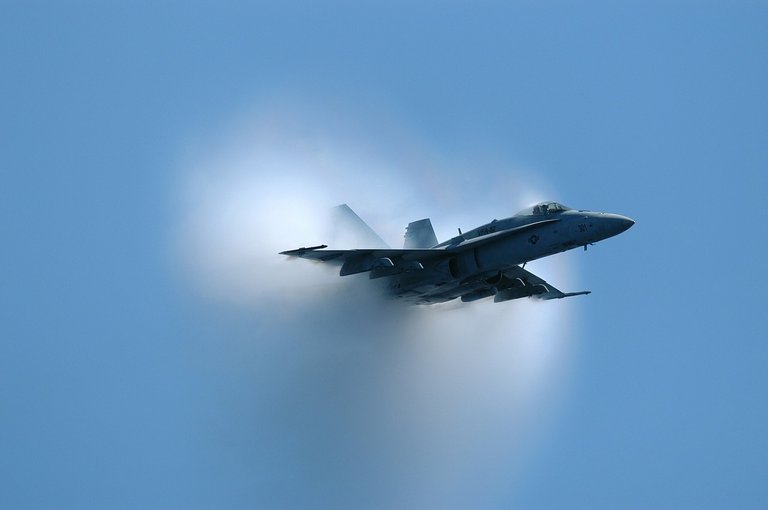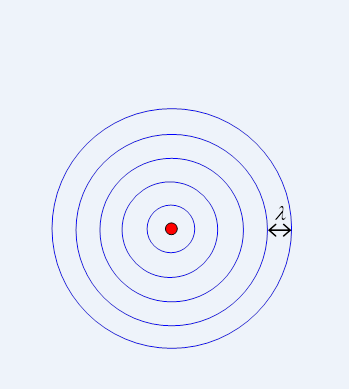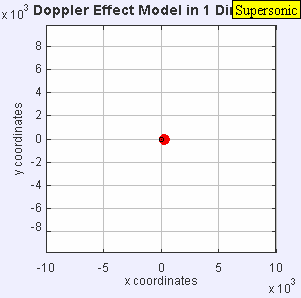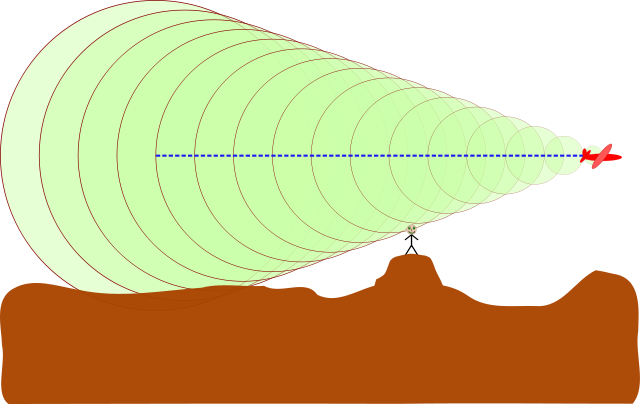
Those of us that watched the launching of Falcon Heavy, Elon Musk's rocket on Feb 6, 2018, heard an unusual sound. Elon made true his promise to put one of the siliest thing he could imagine in orbit; a roadster. You might have noticed a peculiar sound when the two boosters returned to earth.

If you were not privileged to have watched it live, here is a video footage showing the return of the boosters to earth with the accompanying sound.
This sonic boom occurs in aircrafts capable of flying faster than the speed of sound. The speed of sound at 20 °C (68 °F) is 343 meter per second. Such aircraft are said to be supersonic.
The relationship ratio between an object's speed and speed of sound is often measured in Mach number, M.
M= u/c
where
u= flow velocity or object speed.
c= speed of sound which is dependent on the medium of propagation.
when M= 1, this is the speed of sound also known as transonic speed.
When M= 5.0 to 10.0, the speed is said to be hypersonic.
when M is greater than 1 ( typically Mach 1.3 to 5.0) the aircraft is supersonic.
The aircrafts with such capacities include military planes, rockets and only a handful of aircraft used for civilians such as the BAC/Aérospatiale Concorde. and the Russian's Tupolev Tu-144. The two were retired in 2003 and 1983 respectively. Supersonic plane startup company like Boom has plans of making one available: a quiet, supersonic jet airliner by 2020.
Others like Airbus, Virgin Galactic and Lockheed Martin who are the heavy hitters in building commercial aircrafts are also thinking along that direction.
When an aircraft flies at the supersonic speed, it produces a sonic boom. A sonic boom is a loud noise heard when the plane moves at supersonic speed. The intriguing detail about this boom is that it is heard before the sound of the aircraft. That is because of doppler effect. I will talk about that briefly below.
The Anatomy of Sonic Boom
The sound waves are the air molecules under rhythmic vibrations which results in reciprocating expansion and compression of air molecules.
The sound waves expand spherically and for a stationary object, the sound produces an omnidirectional wave which moves in every direction with equidistant wavelengths.

Consider the waves crests of a sound source of an object at rest shown here. For simplicity, the diagram is in 2-D, in real life, it is in 3D.
The generated wave crests are represented by the concentric circles; each circle represents a single wave of compressed air or sound wave. Notice the separation (distance) of each wave crests known as the wavelength, represented by λ is equidistant (is in an equal distance) to each other in every direction.
Frequency of the sound waves f= v/ λ
where the v= speed of the waves
Consider the Fig 4 below. v= object's speed and vs= speed of sound.
The object is moving along x-axis in the direction shown in the arrow in Fig 4. In the first instance, the speed of object v is less than the speed of sound vs i.e, v < vs
When that happens, the compressed air in front of the sound source comes closer together while that behind it grows wider apart. That makes the wavelength λ behind the object to be longer than the wavelength in front of it. We now have a long wavelength at the back of the source, and hence low frequency since λ is indirectly proportional to f Remember λ=c/f There is smaller (shorter) wavelength in front of the sound source which makes for a high frequency. Notice how fast the object is moving relative to the soundwaves. This phenomenon could be seen in everyday life on the changing sound pitch of an ambulance siren as it passes. Another scenario is when the sound source or object v is moving at the same speed of sound vs i.ev = vs From Fig 4, we would see the diagram of v = vs Here the compressed sound waves would reach an observer at the same time. Observe how all the concentric circles representing each sound waves merge. The coming together of this sound waves creates a loud boom. Looking at Fig 4 again, the sound source velocity v is greater than the speed of sound vs at v Here the Mach number is more than 1. The sound waves all merge forming a conelike pattern and a wall depicted by the blue triangle known as the shock wave. The sound waves which now merges to produce a sound that is very loud which could be heard from a long distance. That sound is what is known as a sonic boom. The popping an inflated balloon result in a little supersonic boom. The balloon's torn pieces contracts at supersonic speed. The sound rattles windows and startles both infants and adults. This sonic boom was part of the reason Concorde was banned from flying across the US. At one time during the ban, it was only allowed to fly to Rio and Bahrain. The sonic boom is measured in pounds per square foot of pressure. Most space shuttles are supersonic such as the SpaceX Falcon Heavy. This supersonic flying is usually done during reentry from orbit to reduce the effects of air drag, especially below 30 km altitude. Forty-five seconds after launch, the space shuttle goes supersonic. It increases speed from Mach 1 to 5 after about two minutes of liftoff. Between 1.5 psf and 2, lb may elicit some public reaction from observers. Some observers have endured the pressure of between 20 to 144lb from aircraft flying supersonic at less than 100 feet without damage to any of their organs. Damage to the eardrum occurs at pressure reaching 720lb while the lungs damages at a pressure of 2160 lbs. Sonic booms from these aircrafts could only disrupt sleep, annoy and distract people close to where they fly. References Image Reference Fig 1 [Pixabay]Source: A Supersonic Military Jet Fig 2 [Giphy]Gif of the landing of the Falcon Heavy Booster Fig 3 Sound at Rest [Wikipedia]Fig 4: The Different Characteristis of Sound Waves of a Moving Object Fig 5 [Wikipedia]Gif: Doppler Effect [Wikipedia]A Depiction of a Sonic Boom If you write STEM (Science, Technology, Engineering, and Mathematics) related posts, consider joining #steemSTEM on steemit chat or discord here. If you are from Nigeria, you may want to include the #stemng tag in your post. You can visit this blog by @stemng for more details. You can also check this blog post by @steemstem here and this guidelines here for help on how to be a member of @steemstem.
Fig 4

This situation explains the doppler effect. The effect that makes the sound appear to be high or low depending on the movement of the observer relative to the source. The observer may be stationary, or both source and observer are on the move.> vs.
Effects of Sonic Boom
Aircraft(Speed) Sonic Boom Effect Height(feet) SR-71(Mach 3) 0.9 lb 80,000 Concorde (Mach 2) 1.94 lb 52,000 F-104(Mach 1.93) 0.8lb 48,000 Space shuttle(Mach 1.5) 1.25lb 60,000 (desccent)

Yeah, Christian Doppler did a nice job on explaining the behavior of sound relative to the movement of the observer and it's experienced everyday by someone that is observant. Didn't know US even banned a flight cause of that. Those guys are mean.
The sound was annoying :)
Thank You So much for providing the main theorem which is using to fly a Rocket.
I Heard about that, those boosters are re-useable for Future.
whats your Opinion for that?
The re-usable boosters would greatly reduce the cost of launching payloads to the space. So I think it's a great breakthrough in space travel/exploration.
can we (Normal People) able to buy a Rocket then? 😐
Good.
How are you friend
I'm good. Thank you.
You are welcome
Thanks so much for the educative post, the theorem has also shed light too
Hi @smart-shaegxy, thank you for reading.
So much physics, I hate physics...
How can you hate such a beautiful subject?
HAhahahaha
Another lecture.
Keep it on
Thanks.
Musk now has the fastest roaster ever, 26000 miles per hour. .. Thanks for you earlier upvote.
A roadster that beats the sound barrier :)
Awesome.
Awesome post meeen. My dad will love you, he's a physicist
Nice piece bro but complex I must say...I was only taught the topic "dopler effect" peripherally .
thanks for informative peshalling
oh that's what supersonic meant in that video when it went fly away great to learn about this thanks for sharing @greenrun learnt something new today :)
Yeah. I have witnessed the loud sound made by an aircraft , it is usually unpleasant. Good lecturing.
The only sonic boom I love to hear is the one made by the "man of steel" (Superman) when he's going to catch Lois or save the world. 😀
Man, old articles i missed, but i gotta hand it to ya. You're damn good!
Thanks for the compliment. It's getting harder to keep up these days.